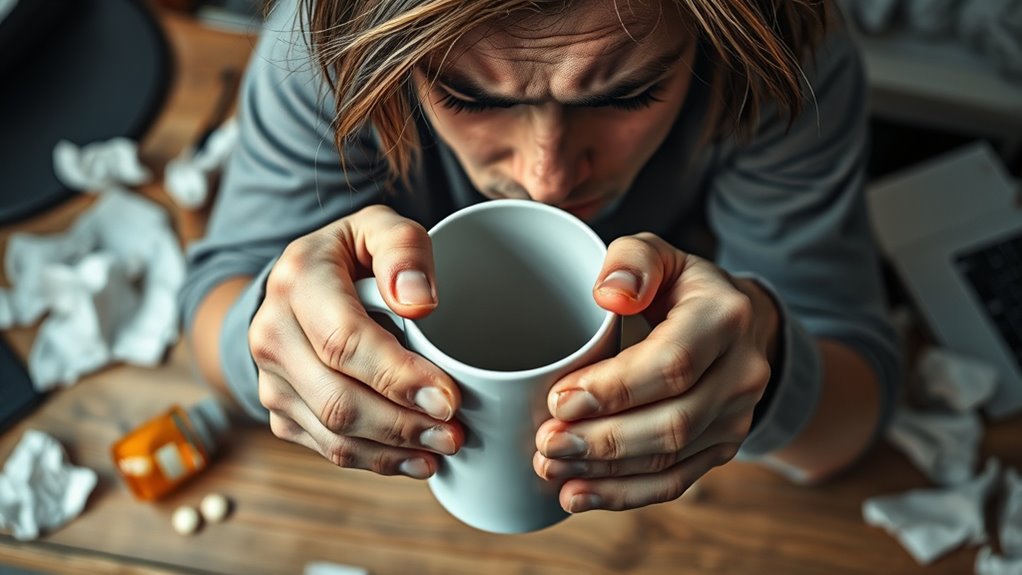When you stop caffeine suddenly, you might notice headaches, fatigue, irritability, and difficulty concentrating, usually within a day or two. These symptoms can last up to a week as your body adjusts to the absence of caffeine’s stimulant effects. To ease withdrawal, gradually cut back on your intake, stay well-hydrated, and rest. Incorporating light exercise and using over-the-counter pain relievers can also help. Keep going, and you’ll find more tips to manage your recovery effectively.
Key Takeaways
- Symptoms typically appear within 12-24 hours and include headaches, fatigue, irritability, and difficulty concentrating.
- Gradually reducing caffeine intake over weeks minimizes withdrawal severity and accelerates recovery.
- Staying well-hydrated, exercising lightly, and resting help alleviate symptoms and support brain adjustment.
- Over-the-counter pain relievers like ibuprofen or acetaminophen can relieve caffeine withdrawal headaches.
- Withdrawal symptoms usually resolve within days to a week with proper management and patience.

If you suddenly stop consuming caffeine, you’ll likely experience withdrawal symptoms within 12 to 24 hours. These symptoms are part of the caffeine withdrawal process, which can last anywhere from 2 to 9 days. The severity of your symptoms depends on how much caffeine you usually consume and for how long. If you’re a heavy coffee drinker, you might notice more intense effects.
Common withdrawal symptoms include headaches, fatigue, irritability, difficulty concentrating, and mood swings. These headaches often develop because caffeine causes blood vessels in your brain to constrict; when you stop, blood vessels dilate, leading to increased blood flow and pressure, which triggers pain. This is why headaches are a hallmark sign of caffeine withdrawal.
Headaches are common as blood vessels dilate after stopping caffeine.
You might also find yourself feeling unusually tired and sluggish, as caffeine’s stimulating effects disappear. Fatigue can make it hard to stay alert or productive, and irritability may set in as your brain adjusts to the lack of caffeine’s mood-enhancing effects. Some people experience difficulty concentrating or notice changes in their mood, feeling more anxious or irritable than usual.
These withdrawal symptoms can be uncomfortable but are temporary, signaling your body adjusting to the absence of caffeine. Reducing caffeine gradually over several weeks can help lessen these symptoms and make the detox process more manageable. Cutting back slowly allows your blood vessels to adapt gradually, reducing the intensity of headaches and other symptoms.
During this period, staying well-hydrated is essential, as hydration supports your body’s recovery and can alleviate some withdrawal discomforts. Drinking plenty of water helps flush out toxins and keeps your blood vessels functioning smoothly. Additionally, incorporating light exercise can help boost your mood and improve circulation during withdrawal.
Over-the-counter pain relievers like ibuprofen or acetaminophen can be effective in easing headaches caused by blood vessel dilation. They provide relief without interfering with the detox process. Remember, it’s best to combine pain relievers with hydration and rest when managing withdrawal symptoms.
Patience is key, as symptoms typically improve within a few days to a week.
Frequently Asked Questions
How to Manage Caffeine Withdrawal?
To manage caffeine withdrawal, you should gradually cut back on your intake over several weeks, helping to prevent severe symptoms.
Stay hydrated with water and electrolyte drinks, and eat nutrient-rich foods to boost your energy naturally.
Incorporate regular exercise, get enough sleep, and practice stress-reduction techniques like meditation.
Over-the-counter pain relievers can ease headaches and muscle aches, making the shift smoother and more manageable.
How Long Does It Take to Detox From Caffeine?
You wanna know how long it takes to detox from caffeine? It usually begins within 12 to 24 hours after you stop, with peak symptoms hitting between 20 to 51 hours.
Most effects fade within 2 to 9 days, though heavy users might take longer.
Some mild symptoms can stick around beyond a week, especially if you drank a lot regularly.
Patience and hydration help you through it.
What Supplement Helps With Caffeine Withdrawal?
You might find magnesium supplements helpful during caffeine withdrawal because they can reduce headaches and muscle cramps.
L-theanine is also beneficial, as it promotes relaxation and helps ease irritability.
B-vitamins support energy levels, reducing fatigue, while 5-HTP can lift your mood and lessen depressive feelings.
Staying hydrated and drinking calming herbal teas like chamomile or valerian can further ease symptoms and support your detox process.
What Foods Help With Caffeine Withdrawal?
You can help ease caffeine withdrawal by eating foods rich in complex carbs like oats, whole grains, and sweet potatoes for sustained energy.
Include antioxidant-rich fruits and vegetables, such as berries and spinach, to reduce inflammation.
Protein sources like eggs, lean meats, and legumes stabilize your mood and blood sugar.
Hydrating foods like watermelon and citrus help prevent headaches.
Nuts and seeds supply essential nutrients for brain health and mood support.
Conclusion
If you’re experiencing caffeine withdrawal, remember that symptoms usually peak within a few days and gradually fade. Stay hydrated, get plenty of rest, and consider reducing your intake gradually to ease the process. Be patient with yourself and know that these symptoms are temporary. With time, your body will adjust, and you’ll feel better. Keep a positive mindset, and soon you’ll be caffeine-free without discomfort.









